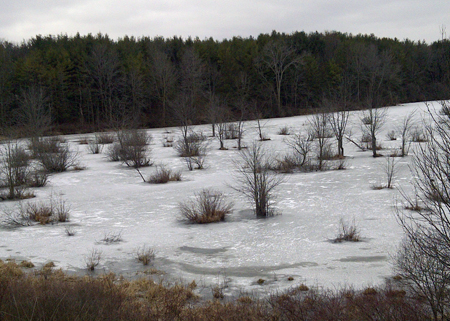Mother nature never ceases to amaze me. Out for a walk the other day I once again noticed how trees were growing in the middle of a local pond. Surrounded by ice in winter and water all year they not only survive, they thrive and reseed themselves. I believe these trees are some kind of maple, given their spectacular orange and red fall colours, but since I haven’t actually climbed down into the pond (nor am I going to) I can’t be sure.
And yet, I watch, sometimes in horror, as high profile landscape companies plant replacement tree after replacement tree in professionally landscaped yards because these trees don’t survive. According to the Colorado State University Extension the average life of a tree in the landscape is only eight years, mostly due to poor design choice and poor planting techniques.
Choosing the right plant for the right place is I think the most important consideration in landscape design. Ignore this and you end up with more maintenance, more disease and insect damage, higher replacement costs and lots of frustration. I’ve been guilty of this myself. A few years ago I just had to have a purple corkscrew hazel, Corylus avellana Red Majestic. After planting it where I thought it would look great in my landscape, I found out rather quickly that there was a couple of downsides. The plant grew too quickly for the space, it sent up green straight suckers faster than I could cut them out and worst of all, the leaves were candy for japanese beetles and nothing could stop them from being completely skeletonized. A hard lesson learned since it took me two years to remove the shrub and pieces that sprouted from remaining roots.
There is an abundance of tree and shrub selection out there to match your needs. So the next time you select a tree or shrub for your yard please keep in mind some of these site conditions:
- light requirements (full sun to deep shade)
- water availability — can or do you want to water regularly, is the area dry or wet by nature
- exposure to wind and temperature extremes
- soil type, drainage, compaction
- hardiness zone
- competition and impact of nearby plants (for example do you have a black walnut nearby, do nearby trees have a dense root system using up all the local moisture)
- space considerations or obstructions
- local insect or disease considerations
While we all love to choose plants for their aesthetics, always keep in mind your sites conditions. Where two plants have similar aesthetic qualities, choose the one that best suits your local conditions. Mother nature is amazing, but even she has limits.

I could go on about poor planting practices when landscapers “install” trees… here in our 70 home development a guy with a truck (I can’t call him a landscaper) put in 140 inappropriate trees (Norway maples and sycamores in every tiny front yard, deeply planted and mulched several feet up the trunk). Half failed, were replanted and failed again. When asked why he always kept the wire basket on the root ball when planting he said “it makes it easier to remove the tree when it dies.”
I’m sure it does.